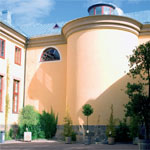


SCAS News - 24 May, 2023
The Sun is Shining and so is Solar Cell Research
Within a couple of years all our energy could come from renewable sources such as solar, wind and
water energy. Marika Edoff, Professor of Solid State Electronics with specialization on solar cells,
pointed this out to me in an interview already twelve years ago. At that point, there was still a hesita-
tion to implement solar energy on a bigger scale, which was partly due to economic and political issues,
but also technical questions such as efficiency of the cells as well as storage and distribution of energy
not consumed directly.
A decade later, things have changed drastically. Even without being immersed in the science of solar
energy, we have all witnessed the increase in solar panels on public and private buildings, the increase
of gadgets utilizing solar cells and also a sense of urgency when talking about sustainable energy pro-
duction.
I was therefore more than delighted to be invited to the Nobel Symposium NS 191: Efficient Light to
Electric Power Conversion for a Renewable Energy Future, hosted by the Swedish Collegium for
Advanced Study in collaboration with Uppsala University. The symposium was organized by Anders Hag-
feldt, Vice Chancellor of Uppsala University and Professor of Physical Chemistry with a research back-
ground
in solar cells, SCAS Principal Christina Garsten, and Marika Edoff herself. During three sunny
days leading
scientists had the chance to present their own progress and discuss with each other.
In a way this was a unique Nobel symposium since it was supported by both the Committee for Physics
and the Committee for Chemistry at the Royal Swedish Academy of Sciences. The science behind solar
energy is a highly multidisciplinary research area within both physics, chemistry and other disciplines.
There is also a long-standing and built-in collaboration with industry. Solar cells are developed and imme-
diately tested, optimized, and improved for large scale use. Development and learning happens while going
along, and using the technique for energy production.
The principle of solar power, or photovoltaics, as it is also called, is to convert light into energy. Nowadays
there are many different materials to achieve this. The development started off with silicon and subsequently
other materials such as dye-sensitized solar cells, thin film solar cells and most recently so-called perovskites
have been explored and optimized for low cost and high efficiency. In the research laboratories the individual
cells are designed and optimized. These are then assembled into modules and panels that you can see on roof-
tops.
During recent years two important factors have been a boost for solar energy: The efficiency of solar cells,
particularly those based on silicon, have gone up at the same time as the cost of production has gone down.
This has been a key for large scale implementation and competition with fossil-based energy sources.
The different types of solar cells are suitable for different applications, and a combination of different kinds
of cells can be potentially powerful. A silicon cell in tandem repeat with a perovskite can for example increase
efficiency. With more and more energy coming from the sun, a current challenge is to figure out storage and
distribution. The increase of use of solar energy also touches on societal and financial issues, as well as
communication with politicians and policy-makers.
The research of photovoltaics is now also starting to break down its own boundaries. Instead of only having
meetings and conferences for each specific solar cell type, the different research groups have started to colla-
borate
to find out how they can learn from one another and what they can do together. Friendly rivalry between
the different subfields will probably always persist (and after all, competing for a new efficiency record can be
a good driving force) but the common goal to contribute to a sustainable future, independent of fossil fuels, is
higher than that. Thoughts and efforts are now also directed towards sustainable solar cell production and
recycling of outlived materials. Another exciting area is agrivoltaics - the use of solar panels on farmland com-
bined with agriculture. There are many smart and creative solutions to integrate solar panels into our lives –
for
example how we build and design housing, vehicles and other products.
I am excited to see what the next decade – or even less - will bring. The symposium gave a bright glimpse into
the future, which will hopefully also bring a Nobel Prize to the research field of photovoltaics.
Written by Natalie von der Lehr
SCAS Talks Podcast - Spotlight:
A collection of voices from the Nobel Symposium NS191: Efficient Light to Electric Power Conversion for a
Renewable Energy Future can be found in the SCAS Talks Podcast Spotlight episode with the same name.
Listen here or in a podcast app of your choice.
Read more:
SCAS News - 3 May 2023: SCAS Hosts Nobel Symposium on Solar Cells >>






